- Publisher's Note
- Editorial
- Looking from the Other Side
- Women in Rabindranath Tagore's Paintings
- Ramkinkar Baij's Santhal Family
- The Birth of Freedom in Moments of Confinement
- Jamini Roy's Art in Retrospect
- The Great Journey of Shapes: Collages of Nandalal Bose
- Haripura Posters by Nandalal Bose: The Context and the Content
- The Post-1960s Scenario in the Art of Bengal
- Art Practice in and Around Kolkata
- Social Concern and Protest
- The Dangers of Deifications
- Gobardhan Ash: The Committed Artist of 1940-s
- Gopal Ghose
- Painting of Dharmanarayan Dasgupta: Social Critique through Fantasy and Satire
- Asit Mondal: Eloquence of Lines
- The Experiential and Aesthetic Works of Samindranath Majumdar
- Luke Jerram: Investigating the Acoustics of Architecture
- Miho Museum: A Structure Embedded in the Landscape
- Antique Victorian Silver
- Up to 78 Million American Dollars1 !
- Random Strokes
- Are We Looking At the Rise of Bengal
- Art Basel and the Questions it Threw Up
- What Happened and What's Forthcoming
- Art Events Kolkata, May – June 2012
- Mumbai Art Sighting
- Delhi Dias
- Art Bengaluru
- Preview June, 2012 – July, 2012
- In the News, June 2012
ART news & views
The Great Journey of Shapes: Collages of Nandalal Bose
Issue No: 30 Month: 7 Year: 2012
by Samindranath Majumdar and Anuradha Ghosh
It was quite a while ago that I came across a catalogue published by the National Gallery of Modern Art, on occasion of Nandalal Bose's centenary, and that was my first brush with his collages. But a substantial, and somewhat staggering encounter came about a year back when I had the opportunity to view a whole body of these astounding works, and hit upon the realization that these in fact stand out in a singular manner, with a deeply embedded significance. In fact the collages constitute a chapter in his career as an artist and art teacher that needs to be closely studied, unraveled and understood in order to be able to make better sense of Nandalal's life and work. A practicing artist who is an art teacher too negotiates between identities that are hardly bipolar, hardly self-limiting, yet the two can be observed and considered distinctly. The collages offer us a fascinating- and useful- reading of this duality.
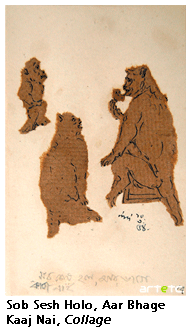
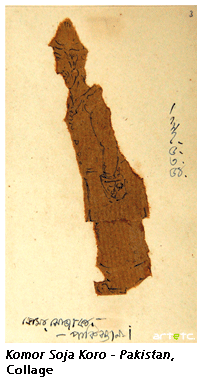
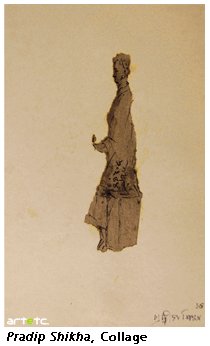
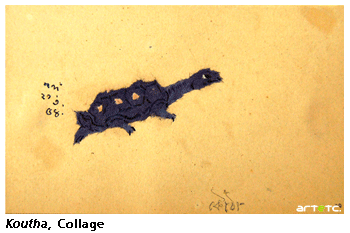 The point of origin of the collages amply illustrates this. Nandalal, in a 1954 letter to Sagarmoy Ghosh, describes in detail how the collages came to be: he was watching Mr Perumal teach students the study of ducks and hens at Gouri Bhanja's home, and the students started showing him their works. With no pencil or drawing paper at hand, Nandalal gathered the paper shreds lying around and tore them to shapes of the birds being studied in order to instruct the students. The next day the students brought some of these back to him, mounted on board, and this was, indeed, a moment of revelation to him: 'thus began a manner of work more powerful in its import than the kind of work with hesitant pencil lines.' The teacher formulated a fresh technique of teaching, and the artist reveled in the possibilities of the newly discovered medium. Nandalal narrates how this new technique fired his creative passion: 'I was constantly picking up pieces of discarded paper, letters, torn envelopes, and giving them shapes.' He had further subdivided the collages into two distinct groups, a classification that clearly underlines the twinness of his identity, the artist as a teacher and the teacher as an artist. He mentions a manner in which the paper is torn without premeditation, the artist yet clueless about referentiality (this also includes 'found' pieces of torn paper), which then undergoes minor parings, a few lines are added to form a shape and a picture. Here is an element of the automatic, the instinctive, that pays court to the intuition of the artist. The other technique, as he himself insists, is wonderfully effective in case of teaching. This involves deciding upon the shape first, and tearing the paper according to the dictates of the preconceived shape. This manner, Nandalal agrees, effectively lacks 'simplicity' and 'boldness'- it is interesting to see that for him it is still acceptable only because this proved invaluable for learning, and teaching, the features of shape and form. The collages provided, in a manner of speaking, a fresh new creative space for the artist, and an effective tool to the teacher.
The point of origin of the collages amply illustrates this. Nandalal, in a 1954 letter to Sagarmoy Ghosh, describes in detail how the collages came to be: he was watching Mr Perumal teach students the study of ducks and hens at Gouri Bhanja's home, and the students started showing him their works. With no pencil or drawing paper at hand, Nandalal gathered the paper shreds lying around and tore them to shapes of the birds being studied in order to instruct the students. The next day the students brought some of these back to him, mounted on board, and this was, indeed, a moment of revelation to him: 'thus began a manner of work more powerful in its import than the kind of work with hesitant pencil lines.' The teacher formulated a fresh technique of teaching, and the artist reveled in the possibilities of the newly discovered medium. Nandalal narrates how this new technique fired his creative passion: 'I was constantly picking up pieces of discarded paper, letters, torn envelopes, and giving them shapes.' He had further subdivided the collages into two distinct groups, a classification that clearly underlines the twinness of his identity, the artist as a teacher and the teacher as an artist. He mentions a manner in which the paper is torn without premeditation, the artist yet clueless about referentiality (this also includes 'found' pieces of torn paper), which then undergoes minor parings, a few lines are added to form a shape and a picture. Here is an element of the automatic, the instinctive, that pays court to the intuition of the artist. The other technique, as he himself insists, is wonderfully effective in case of teaching. This involves deciding upon the shape first, and tearing the paper according to the dictates of the preconceived shape. This manner, Nandalal agrees, effectively lacks 'simplicity' and 'boldness'- it is interesting to see that for him it is still acceptable only because this proved invaluable for learning, and teaching, the features of shape and form. The collages provided, in a manner of speaking, a fresh new creative space for the artist, and an effective tool to the teacher.
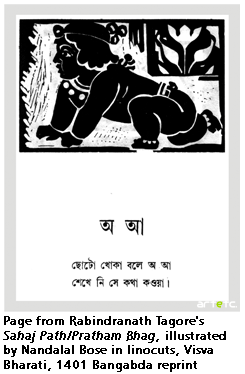 Nandalal himself called these works 'hela-felar kaj'. I can roughly translate 'hela-fela' as 'uncared-for', but then this labeling would ignore the basic element of meticulous care that underlay every work that he ever produced. I would rather connect a certain kind of playfulness, a perceived freedom, with this singular group of works. One notes, though, umpteen correspondences here with his earlier drawings- maybe with the exception that Nandalal's drawings include, in most cases, the use of careful detailing. Having considered the incidental nature of the beginning, one would still wonder what impelled the ageing artist to engage in creating this sizeable series with such passion and verve. We may remind ourselves, though, that old age and infirmity had effected notable alterations in the manner of work in case of quite a few artists, opened up new directions, destinations unknown and exciting. The name that we readily remember in this connection is that of Matisse, whose stint with cut-out/collage started when he was seventy-two, and confined to a wheelchair: physical infirmity had clearly been an operative factor here. We stumble upon a very interesting coincidence when we note that Nandalal himself was seventy-two as well, and physically ailing, when his preoccupation with the collages began. Matisse's artist's book 'Jazz' published in 1947 includes many of his cut-outs, most of which are principally designal. These differ from Nandalal's series primarily on the point of deliberateness of intent. Matisse used scissors, thus effecting a cleaner edge, cutting away a shape that he had already decided upon, while Nandalal- as I had already mentioned before- largely depended on unpremeditation. He was working almost like the Zen artists, working with accidents, molding an existing shape into significant form with minor alterations. I am reminded of the 'readymade' sculptures, especially the one by Picasso, the 'Bull's head', where he brought together the seat and other parts of a cycle to create a unique referentiality. Or, maybe, Abanindranath as well. His famous 'Kutum Katam' utilized found objects- parts of tree branches, mostly- and with the help of playful additions and deletions created interesting formal structures. Abanindranath had used collage in his 272-page scrap book titled Khuddur Yatra (1934 to1942) and Rabindranath too, if we care to remember, had pasted cut-out parts of his paintings onto another surface. It is extremely probable that the subconscious recollection of such experiments had honed his eagerness for the new medium, however accidental the starting point might be. There are other links too, interesting ones, worth observing closely. For one, the collages are, principally, silhouette forms, with minimal lines that indicate and emphasize the form- whether human/animal/bird- and this recalls the Tagores once again. Gaganendranath Tagore had used silhouette figures in his paintings, and one is also reminded of Rabindranath's silhouettes, with their notable dirth of details. One can only observe, and ponder upon, the feasibility of connecting these separate yet similar strands- but a clear pronouncement would probably be somewhat presumptious. But what is unquestionably present as a strong stylistic connection is Nandalal's abiding interest in graphic art. Nandalal, almost a founding father of linocut in India, experimented with this medium in the unforgettable illustrations of Sahaj Path- a Bangla primer for children written by Tagore which has not lost its relevance till this day. The talking point is, these works treat figures and objects as a solid, monochromatic mass- black, in most cases- while only a few white lines, details, situate and define them. In a sense, Nandalal is using the same technique in his collages. Same, yes, but this sameness is also mediated by the possibilities of a separate medium. For example, the clean, sharp contour lines typical of linocut are completely absent here. They are replaced by serrated, yet sensitive, contours induced by the edge of the paper torn by hand. There is no sharpness, no abruptness of demarcation, as if the piece of paper falls into place against the background in a spirit of easy companionship. The paper scrap finds belonging here, while the background gains animation and meaning from this tiny piece. A scissor cut spells complete secession: these serrated tearings are situated in a diametrically opposed point, they bind and blend.
Nandalal himself called these works 'hela-felar kaj'. I can roughly translate 'hela-fela' as 'uncared-for', but then this labeling would ignore the basic element of meticulous care that underlay every work that he ever produced. I would rather connect a certain kind of playfulness, a perceived freedom, with this singular group of works. One notes, though, umpteen correspondences here with his earlier drawings- maybe with the exception that Nandalal's drawings include, in most cases, the use of careful detailing. Having considered the incidental nature of the beginning, one would still wonder what impelled the ageing artist to engage in creating this sizeable series with such passion and verve. We may remind ourselves, though, that old age and infirmity had effected notable alterations in the manner of work in case of quite a few artists, opened up new directions, destinations unknown and exciting. The name that we readily remember in this connection is that of Matisse, whose stint with cut-out/collage started when he was seventy-two, and confined to a wheelchair: physical infirmity had clearly been an operative factor here. We stumble upon a very interesting coincidence when we note that Nandalal himself was seventy-two as well, and physically ailing, when his preoccupation with the collages began. Matisse's artist's book 'Jazz' published in 1947 includes many of his cut-outs, most of which are principally designal. These differ from Nandalal's series primarily on the point of deliberateness of intent. Matisse used scissors, thus effecting a cleaner edge, cutting away a shape that he had already decided upon, while Nandalal- as I had already mentioned before- largely depended on unpremeditation. He was working almost like the Zen artists, working with accidents, molding an existing shape into significant form with minor alterations. I am reminded of the 'readymade' sculptures, especially the one by Picasso, the 'Bull's head', where he brought together the seat and other parts of a cycle to create a unique referentiality. Or, maybe, Abanindranath as well. His famous 'Kutum Katam' utilized found objects- parts of tree branches, mostly- and with the help of playful additions and deletions created interesting formal structures. Abanindranath had used collage in his 272-page scrap book titled Khuddur Yatra (1934 to1942) and Rabindranath too, if we care to remember, had pasted cut-out parts of his paintings onto another surface. It is extremely probable that the subconscious recollection of such experiments had honed his eagerness for the new medium, however accidental the starting point might be. There are other links too, interesting ones, worth observing closely. For one, the collages are, principally, silhouette forms, with minimal lines that indicate and emphasize the form- whether human/animal/bird- and this recalls the Tagores once again. Gaganendranath Tagore had used silhouette figures in his paintings, and one is also reminded of Rabindranath's silhouettes, with their notable dirth of details. One can only observe, and ponder upon, the feasibility of connecting these separate yet similar strands- but a clear pronouncement would probably be somewhat presumptious. But what is unquestionably present as a strong stylistic connection is Nandalal's abiding interest in graphic art. Nandalal, almost a founding father of linocut in India, experimented with this medium in the unforgettable illustrations of Sahaj Path- a Bangla primer for children written by Tagore which has not lost its relevance till this day. The talking point is, these works treat figures and objects as a solid, monochromatic mass- black, in most cases- while only a few white lines, details, situate and define them. In a sense, Nandalal is using the same technique in his collages. Same, yes, but this sameness is also mediated by the possibilities of a separate medium. For example, the clean, sharp contour lines typical of linocut are completely absent here. They are replaced by serrated, yet sensitive, contours induced by the edge of the paper torn by hand. There is no sharpness, no abruptness of demarcation, as if the piece of paper falls into place against the background in a spirit of easy companionship. The paper scrap finds belonging here, while the background gains animation and meaning from this tiny piece. A scissor cut spells complete secession: these serrated tearings are situated in a diametrically opposed point, they bind and blend.
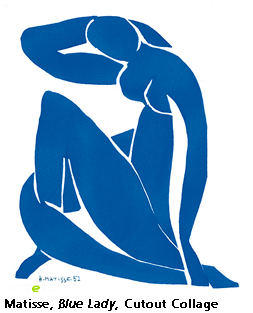

Nandalal's use of space- blank space, that is, which usually forms the background and often surrounds the elements-, has interesting dimensions. Blankness, emptiness as backdrop is not a new encounter for us: it is present in our folk tradition, in our chouko pat/kalighat pat, even in innumerable Jamini Roy works. Yet it is evident that Nandalal's use of empty space owes less to the various strands of our folk tradition than to the distinctive use of void in Chinese paintings. In most kalighat pats, the empty backdrop is just that- a backdrop- which exists only as negative space, the emptiness operative in foregrounding the full-focus spectacle. It is not meant to exist on its own, and in many works we hardly get to see a sufficiently large part of it. The focus, understandably, is on the centre-stage story narrated by the pictures - bright, adorned and voluminous- and therefore it would be unjustified to link Nandalal's use of emptiness to the folk tradition. Void in Chinese painting is a distinct story altogether, with its philosophical underpinning, its felt presence: the void is instrumental in signifying the harmony of the universe, the very flow of life in a sense. Emptiness, thus, is almost a signifier here, and in Nandalal's collages too, we recognise a similar import. There are some works, though, where the skilful use of perspective and arrangement transform the blankness into a recognizable topographical unit, situating the figure with a visual rationale. For example, this work dated 3 March, 1954 portrays a woman from what appears to be a high-angle point of view. The empty space, within which the figure would have seemed suspended otherwise, visually rearranges itself around the figure because of the perspective so that she appears to be solidly situated. The pictorial space beneath her feet transforms, therefore, into a clear foreground. Whichever way we look at it, one can pronounce with considerable justification that the collages treat empty space with considerable reverence.
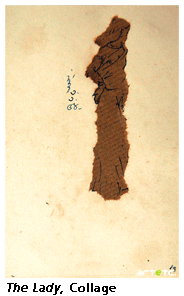

A notable feature of the collages is the airy lightness of temper that accompanies them as a continuing undertone. We must remember that these works were done speedily, and this very fastness of execution had possibly lent these a flavor of a passing, fleeting thought. Here's no weighing down with serious reflections, pensive musings- rather, at times, a barely noticeable strain of humor emerges and defines the mood of the work. This impression is reinforced by the frequent commentaries that Nandalal added to the collages, text that helped him situate his figures within a clear narrative frame. And in many cases, such text hinged upon contemporaneity: these sought to capture the temporal through allusions to recent events. Shall we call them, then, pictorial chronicles? A case in point would be this very interesting work where two pieces of paper have been joined and pasted on board in such a manner that the shape denotes a Muslim man- his posture clearly indicates some ailment involving the waist and midriff. This collage, executed on 5 March 1954, carries the text 'Straighten thy back, Pakistan!' A straightforward political commentary? Or, perhaps, an astute observation from a person who is wide awake to the political equations all around him? The work that portrays three monkeys displays the same awareness. The monkeys are seen to divide a cake among themselves- three pieces, understandably- alluding to the popular adage of cake-sharing of monkeys. The whole narrative takes on a deeper significance as soon as the text 'no need to divide things further' is added to it; one may justifiably surmise that the three pieces refer to India, Pakistan and East Pakistan (which later became Bangladesh). We must keep in mind that in spite of technically being the same country, Pakistan and East Pakistan had always been somewhat distinct entities in popular imagination because of their geographical and cultural distance. 'The Flame', too, is an interesting work. The woman who bears the lamp here is clearly a foreigner with short and curly hair, her elongated frame clothed in a gown: does she resemble Sister Nivedita? Sister's contribution to Indian art movements can hardly be over-emphasized- it is thus entirely possible that she inhabited the imagination of Nandalal more as the actual glowing flame rather than as its bearer.
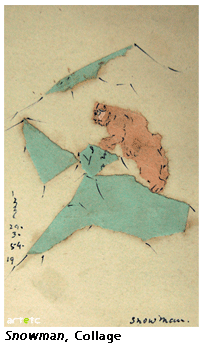
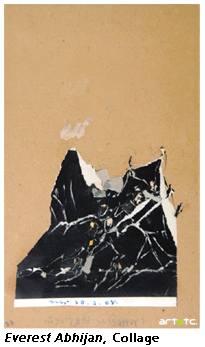
Equally interesting is the 1954 work titled Everest Expedition, which is very clearly a chronicle of a contemporary event that rocked the world and took place less than a year ago, in May 1953. This is a singular work which differs substantially from another collage concerning mountains- Snow Man, in which one catches the impression of mountains stretching away. This sense of a wide hilly expanse is conspicuously absent in the Everest collage (though the cloud on top of Mount Everest has a unique tactile quality, created by peeling off an outer layer of paper, thus achieving a translucent thinness) . Here the mountain seems to be snipped, recast in a fixed frame with space all around, rather like a clipped newspaper snap. I'd venture to say that he is pictorially representing a rather significant snippet of news, and that is precisely why he refrains from focusing upon the panoramic expanse. The principal focus here, after all, is the feat of humans, the victory over nature. The mountain, as a vanquished element, lies framed (bounded?) and therefore reduced.
 These representational works can hardly be called realistic: the simplification of form and gesture that had been instrumental behind their creation is also the principal factor in infusing, what may with facility be called a certain quality of abstraction. A case in point would be the work titled 'Fur Coat', where a brown paper envelope and its gummed, darker side is used to bring out a figure considerably simplified, yet recognizable as a person wearing a long, sweeping fur coat. The sense of control of the artist is admirable, especially when we consider the fact that not a single line is drawn to define the collage further.
These representational works can hardly be called realistic: the simplification of form and gesture that had been instrumental behind their creation is also the principal factor in infusing, what may with facility be called a certain quality of abstraction. A case in point would be the work titled 'Fur Coat', where a brown paper envelope and its gummed, darker side is used to bring out a figure considerably simplified, yet recognizable as a person wearing a long, sweeping fur coat. The sense of control of the artist is admirable, especially when we consider the fact that not a single line is drawn to define the collage further.
Abstraction essentially involves the factor of deconstruction and reconstruction of meaning, the viewer is inexorably drawn thus into the creative process. In some of these works, the narration too deviates from the space of a fixed discourse and attains semantic fluidity. I am reminded of this notable work where two longish pieces of white paper are pasted on a yellowish board, the pieces resembling two tall figures with upturned faces. One is akin to a lion-like animal, the other appears to be a calm, composed sage. The first has the word 'outside' written beneath it, while the second figure has 'inside' written below. We can only wonder at what he might have wanted to denote: since the work is titled 'oneness is what the philosopher sees', we are led to ponder upon whether a visionary splits the apparent into mutually opposing, yet congruent, selves. Or better still, we are confronted with the projected coexistence of the god and the beast! And it is precisely here that the significance of the denotation lies, in the opening up of multiple directions through the vocabulary of hints.
Rabindranath had mentioned once, talking about his doodles, that his work was 'akarer mahajatra'- the great journey of shapes. Precisely this feeling returns again and again as a resounding echo during our encounter with Nandalal's collages, which justifiably constitute one of the most significant phases of his career, one which is both a culmination and a new beginning.